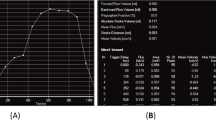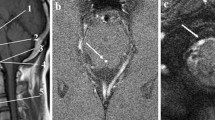Abstract
Introduction
Differential radiologic diagnosis of cystic malformations of the posterior fossa is often difficult with conventional imaging techniques because of overlapping features of these entities. Posterior fossa cystic malformations occupy the cerebrospinal fluid (CSF) spaces. They may create secondary dynamic effects on the movements of CSF. The aim of this study was to investigate CSF flow alterations in posterior fossa cystic malformations with CSF flow MR imaging.
Methods
The study included 40 patients with cystic malformations of the posterior fossa. The patients underwent cardiac-gated phase-contrast cine MR imaging. CSF flow was qualitatively evaluated using an in-plane phase-contrast sequence in the midsagittal plane. The MR images were displayed in a closed-loop cine format.
Results
Twelve of the patients had communicating arachnoid cyst, seven had non-communicating arachnoid cyst, ten had mega cisterna magna, six had Dandy-Walker malformation, two had Dandy-Walker variant, and three had Blake’s pouch cyst. CSF flow MR imaging indicated the regions of no, slow or higher flow, direction of flow, and abnormal cystic fluid motion. Each malformation displayed a distinct CSF flow pattern.
Conclusion
Phase-contrast cine MR imaging for CSF flow evaluation may be a useful adjunct to routine MR imaging in the evaluation of the cystic malformations of the posterior fossa because it can improve the specificity in differentiating such malformations.








Similar content being viewed by others
References
Robertson R, Caruso PA, Truwit CL, Barkovich AJ (2002) Disorders of brain development. In: Atlas SW (ed) Magnetic resonance imaging of the brain and spine. Lippincott Williams & Wilkins, Philadelphia, pp 279–369
Quencer RM, Post MJ, Hinks RS (1990) Cine MR in the evaluation of normal and abnormal CSF flow: intracranial and intraspinal studies. Neuroradiology 32:371–391
Curless RG, Quencer RM, Katz DA, Campanioni M (1992) Magnetic resonance demonstration of intracranial CSF flow in children. Neurology 42:377–381
Bhadelia RA, Bogdan AR, Wolpert SM (1995) Analysis of cerebrospinal fluid flow waveforms with gated phase-contrast MR velocity measurements. AJNR Am J Neuroradiol 16:389–400
Barkhof F, Kouwenhoven M, Scheltens P, Sprenger M, Algra P, Valk J (1994) Phase-contrast cine MR imaging of normal aqueductal CSF flow. Effect of aging and relation to CSF void on modulus MR. Acta Radiol 35:123–130
Naidich TP, Altman NR, Gonzales-Arias SM (1993) Phase contrast cine magnetic resonance imaging: normal cerebrospinal fluid oscillation and applications to hydrocephalus. Neurosurg Clin N Am 4:677–705
Bhadelia RA, Bogdan AR, Kaplan RF, Wolpert SM (1997) Cerebrospinal fluid pulsation amplitude and its quantitative relationship to cerebral blood flow pulsations: a phase-contrast MR flow imaging study. Neuroradiology 39:258–264
Bradley WG Jr, Scalzo D, Queralt J, et al (1996) Normal-pressure hydrocephalus: evaluation with cerebrospinal fluid flow measurements at MR imaging. Radiology 198:523–529
Enzmann DR, Pelc NJ (1993) Cerebrospinal fluid flow measured by phase-contrast cine MR. AJNR Am J Neuroradiol 14:1301–1307
Schroeder HW, Schweim C, Schweim KH, Gaab MR (2000) Analysis of aqueductal cerebrospinal fluid flow after endoscopic aqueductoplasty by using cine phase-contrast magnetic resonance imaging. J Neurosurg 93:237–244
Nitz WR, Bradley WG Jr, Watanabe AS, et al (1992) Flow dynamics of cerebrospinal fluid: assessment with phase-contrast velocity MR imaging performed with retrospective cardiac gating. Radiology 183:395–405
Enzmann DR, Pelc NJ (1991) Normal flow patterns of intracranial and cerebrospinal fluid defined with phase-contrast cine MR imaging. Radiology 178:467–474
Hoffmann KT, Hosten N, Meyer BU, et al (2000) CSF flow studies of intracranial cysts and cyst-like lesions achieved using reversed fast imaging with steady-state precession MR sequences. AJNR Am J Neuroradiol 21:493–502
Yildiz H, Erdogan C, Yalcin R, et al (2005) Evaluation of communication between intracranial arachnoid cysts and cisterns with phase-contrast cine MR imaging. AJNR Am J Neuroradiol 26:145–151
Kadowaki C, Hara M, Numoto M, et al (1995) Cine magnetic resonance imaging of aqueductal stenosis. Childs Nerv Syst 11:107–111
Kim MH, Shin KM, Song JH (1998) Cine MR CSF flow study in hydrocephalus: what are the valuable parameters? Acta Neurochir Suppl 71:343–346
Eguchi T, Taoka T, Nikaido Y, et al (1996) Cine-magnetic resonance imaging evaluation of communication between middle cranial fossa arachnoid cysts and cisterns. Neurol Med Chir 36:353–357
Quencer RM (1992) Intracranial CSF flow in pediatric hydrocephalus: evaluation with cine-MR imaging. AJNR Am J Neuroradiol 13:601–608
Arai H, Sato K (1991) Posterior fossa cysts: clinical, neuroradiological and surgical features. Childs Nerv Syst 7:156–164
Tan EC, Takagi T, Karasawa K (1995) Posterior fossa cystic lesions – magnetic resonance imaging manifestations. Brain Dev 17:418–424
Nelson MD, Karima M, Gilles FH (2004) A different approach to cysts of the posterior fossa. Pediatr Radiol 34:720–732
Barkovich AJ, Kjos BO, Norman D, Edwards MS (1989) Revised classification of posterior fossa cysts and cystlike malformations based on the results of multiplanar MR imaging. AJR Am J Roentgenol 153:1289–1300
Tortori-Donati P, Fondelli MP, Rossi A, Carini S (1995) Cystic malformations of the posterior fossa originating from a defect of the posterior membranous area. Mega cisterna magna and persisting Blake’s pouch: two separate entities. Childs Nerv Syst 12:303–308
Harwood-Nash D, Fitz C (eds) (1976) Neuroradiology in infants and children. Mosby, St. Louis, pp 1014–1019
Barkovich AJ (1976) Congenital malformations of the brain and skull. In: Barkovich AJ (ed) Pediatric neuroimaging. Lippincott Williams & Wilkins, Philadelphia, pp 251–381
Altman NR, Naidich TP, Braffman BH (1992) Posterior fossa malformations. AJNR Am J Neuroradiol 13:691–724
Osenbach RK, Menezes AH (1992) Diagnosis and management of the Dandy-Walker malformation: 30 years of experience. Pediatr Neurosurg 18:179–189
Peter JC, Fieggen G (1999) Congenital malformations of the brain – a neurosurgical perspective at the close of the twentieth century. Childs Nerv Syst 15:635–645
Raybaud C (1982) Cystic malformations of the posterior fossa. Abnormalities associated with the development of the roof of the fourth ventricle and adjacent meningeal structures. J Neuroradiol 9:103–133
Kollias SS, Ball WS Jr, Prenger EC (1993) Cystic malformations of the posterior fossa: differential diagnosis clarified through embryologic analysis. Radiographics 13:1211–1231
Calabrò F, Arcuri T, Jinkins JR (2000) Blake’s pouch cyst: an entity within the Dandy-Walker continuum. Neuroradiology 42:290–295
Rengachary SS, Watanabe I (1981) Ultrastructure and pathogenesis of intracranial arachnoid cysts. J Neuropathol Exp Neurol 40:61–83
Crisi G, Calo M, De Santis M, Angiari P, Merli GA (1984) Metrizamide-enhanced computed tomography of intracranial arachnoid cysts. J Comput Assist Tomogr 8:928–935
Miyajima M, Arai H, Okuda O, et al (2000) Possible origin of suprasellar arachnoid cysts: neuroimaging and neurosurgical observations in nine cases. J Neurosurg 93:62–67
Shigemori M, Okura A, Takahashi Y, et al (1996) New surgical treatment of middle fossa arachnoid cyst. Surg Neurol 45:189–192
Hough DR, Mengel MB, Malik AH (1982) Mega cisterna magna: diagnosis using metrizamide computed tomographic cisternography. Neurosurgery 11:260–262
Wolpert SM, Scott RM (1981) The value of metrizamide CT cisternography in the management of cerebral arachnoid cysts. AJNR Am J Neuroradiol 2:29–35
Galassi E, Tognetti F, Frank F, Fagioli L, Nasi MT, Gaist G (1985) Infratentorial arachnoid cysts. J Neurosurg 63:210–217
Naidich TP, Radkowski MA, Bernsten RA, Tan WS (1986) Congenital malformations of the posterior fossa. In: Taveras JM, Ferrucci JT (eds) Radiology. Lippincott, Philedelphia, pp 1–17
Klein O, Pierre-Kahn A, Boddaert N, Parisot D, Brunelle F (2003) Dandy-Walker malformation: prenatal diagnosis and prognosis. Childs Nerv Syst 19:484–489
Patel S, Barkovich AJ (2002) Analysis and classification of cerebellar malformations. AJNR Am J Neuroradiol 23:1074–1087
Acknowledgement
We gratefully acknowledge Fatih Kantarci, MD, for his suggestions and for reviewing of the manuscript.
Conflict of interest statement
We declare that we have no conflict of interest.
Author information
Authors and Affiliations
Corresponding author
Additional information
Part of this article was presented as a poster exhibition at the ESNR 28th Annual Congress and 12th Advanced Course, 11–14 September 2003, Istanbul.
Electronic supplementary materials
Below is the link to the electronic supplementary materials.
Movie 1
Midsagittal closed looped phase contrast cine-MR image for Dandy-Walker Malformation
Movie 2
Midsagittal closed looped phase contrast cine-MR image for Dandy-Walker variant
Movie 3
Midsagittal closed looped phase contrast cine-MR image for Mega cisterna magna
Movie 4
Midsagittal closed looped phase contrast cine-MR image for Communicating arachnoid cyst
Movie 5
Midsagittal closed looped phase contrast cine-MR image for Non-communicating arachnoid cyst
Illustration 1
Dandy-Walker malformation
Midsagittal illustration shows that the tentorium is elevated, and the posterior fossa is markedly enlarged. The vermis is dysgenetic. An enormous 4th ventricle fills the large posterior fossa. The brain stem is compressed against the clivus
Illustration 2
Dandy-Walker variant
Midsagittal illustration shows hypoplasia of the cerebellar vermis, and dilatation of the 4th ventricle and the posterior fossa. There is no compression of the cerebellum and the brain stem
Illustration 3
Blake’s pouch cyst
Midsagittal illustration shows mass effect of the cyst on the inferior vermis and media cerebellar hemispheres. The cyst is displaces the inferior vermis upwards, and the 4th ventricle is dilated but not dilatation the posterior fossa. The tentorium is not elevated
Illustration 4
Mega cisterna magna
Midsagittal illustration shows enlarged retrocerebellar cistern, intact vermis, and internal scalloping of the occipital bone. The tentorium is not elevated. The 4th ventricle and the cerebellum appears normal
Illustration 5
Communicating arachnoid cyst
Midsagittal illustration shows mild high tentorium and scalloping of the inner table of the occipital bone. The 4th ventricle and the cerebellum appears normal
Illustration 6
Non-communicating arachnoid cyst
Midsagittal illustration shows a large retrocerebellar cyst compressing the cerebellum, 4th ventricle and brain stem, scalloping of the inner table of the occipital bone, enlarging the posterior fossa, and elevating the tentorium
Rights and permissions
About this article
Cite this article
Yildiz, H., Yazici, Z., Hakyemez, B. et al. Evaluation of CSF flow patterns of posterior fossa cystic malformations using CSF flow MR imaging. Neuroradiology 48, 595–605 (2006). https://doi.org/10.1007/s00234-006-0098-8
Received:
Accepted:
Published:
Issue Date:
DOI: https://doi.org/10.1007/s00234-006-0098-8




